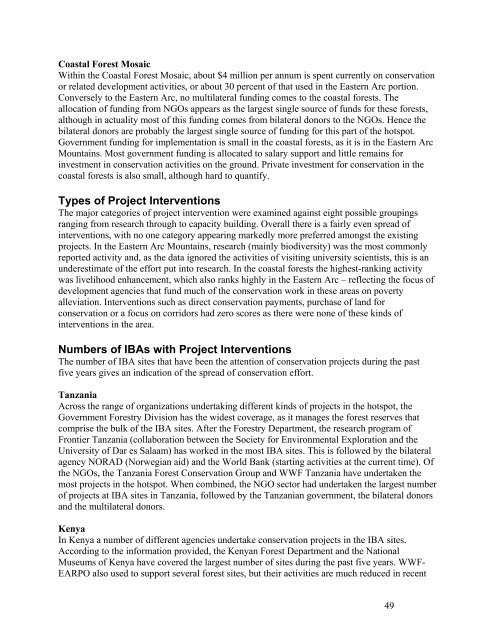Eastern Arc Mountains and Coastal Forests of Tanzania and Kenya ...
Eastern Arc Mountains and Coastal Forests of Tanzania and Kenya ...
Eastern Arc Mountains and Coastal Forests of Tanzania and Kenya ...
Create successful ePaper yourself
Turn your PDF publications into a flip-book with our unique Google optimized e-Paper software.
<strong>Coastal</strong> Forest MosaicWithin the <strong>Coastal</strong> Forest Mosaic, about $4 million per annum is spent currently on conservationor related development activities, or about 30 percent <strong>of</strong> that used in the <strong>Eastern</strong> <strong>Arc</strong> portion.Conversely to the <strong>Eastern</strong> <strong>Arc</strong>, no multilateral funding comes to the coastal forests. Theallocation <strong>of</strong> funding from NGOs appears as the largest single source <strong>of</strong> funds for these forests,although in actuality most <strong>of</strong> this funding comes from bilateral donors to the NGOs. Hence thebilateral donors are probably the largest single source <strong>of</strong> funding for this part <strong>of</strong> the hotspot.Government funding for implementation is small in the coastal forests, as it is in the <strong>Eastern</strong> <strong>Arc</strong><strong>Mountains</strong>. Most government funding is allocated to salary support <strong>and</strong> little remains forinvestment in conservation activities on the ground. Private investment for conservation in thecoastal forests is also small, although hard to quantify.Types <strong>of</strong> Project InterventionsThe major categories <strong>of</strong> project intervention were examined against eight possible groupingsranging from research through to capacity building. Overall there is a fairly even spread <strong>of</strong>interventions, with no one category appearing markedly more preferred amongst the existingprojects. In the <strong>Eastern</strong> <strong>Arc</strong> <strong>Mountains</strong>, research (mainly biodiversity) was the most commonlyreported activity <strong>and</strong>, as the data ignored the activities <strong>of</strong> visiting university scientists, this is anunderestimate <strong>of</strong> the effort put into research. In the coastal forests the highest-ranking activitywas livelihood enhancement, which also ranks highly in the <strong>Eastern</strong> <strong>Arc</strong> – reflecting the focus <strong>of</strong>development agencies that fund much <strong>of</strong> the conservation work in these areas on povertyalleviation. Interventions such as direct conservation payments, purchase <strong>of</strong> l<strong>and</strong> forconservation or a focus on corridors had zero scores as there were none <strong>of</strong> these kinds <strong>of</strong>interventions in the area.Numbers <strong>of</strong> IBAs with Project InterventionsThe number <strong>of</strong> IBA sites that have been the attention <strong>of</strong> conservation projects during the pastfive years gives an indication <strong>of</strong> the spread <strong>of</strong> conservation effort.<strong>Tanzania</strong>Across the range <strong>of</strong> organizations undertaking different kinds <strong>of</strong> projects in the hotspot, theGovernment Forestry Division has the widest coverage, as it manages the forest reserves thatcomprise the bulk <strong>of</strong> the IBA sites. After the Forestry Department, the research program <strong>of</strong>Frontier <strong>Tanzania</strong> (collaboration between the Society for Environmental Exploration <strong>and</strong> theUniversity <strong>of</strong> Dar es Salaam) has worked in the most IBA sites. This is followed by the bilateralagency NORAD (Norwegian aid) <strong>and</strong> the World Bank (starting activities at the current time). Ofthe NGOs, the <strong>Tanzania</strong> Forest Conservation Group <strong>and</strong> WWF <strong>Tanzania</strong> have undertaken themost projects in the hotspot. When combined, the NGO sector had undertaken the largest number<strong>of</strong> projects at IBA sites in <strong>Tanzania</strong>, followed by the <strong>Tanzania</strong>n government, the bilateral donors<strong>and</strong> the multilateral donors.<strong>Kenya</strong>In <strong>Kenya</strong> a number <strong>of</strong> different agencies undertake conservation projects in the IBA sites.According to the information provided, the <strong>Kenya</strong>n Forest Department <strong>and</strong> the NationalMuseums <strong>of</strong> <strong>Kenya</strong> have covered the largest number <strong>of</strong> sites during the past five years. WWF-EARPO also used to support several forest sites, but their activities are much reduced in recent49
















